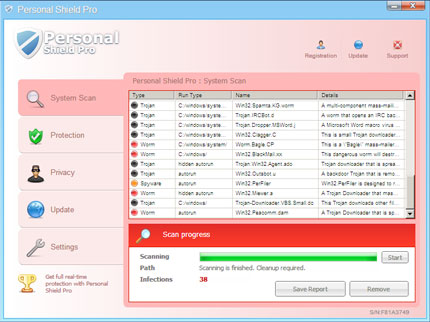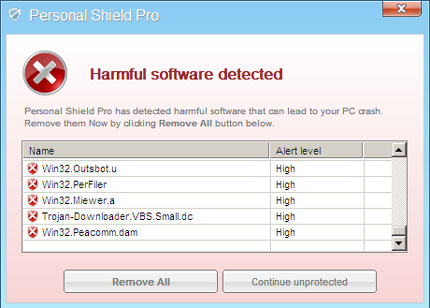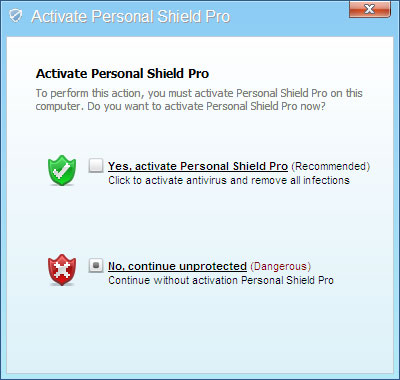TROJ_FAKEAV.SMHB
Rogue:Win32/Winwebsec (Microsoft); FakeAlert-SecurityTool.bt (Mcafee)
Windows 2000, Windows XP, Windows Server 2003


Threat Type: Trojan
Destructiveness: No
Encrypted: No
In the wild: Yes
OVERVIEW
This Trojan may be downloaded from remote sites by other malware.
It connects to certain URLs. It may do this to remotely inform a malicious user of its installation. It may also do this to download possibly malicious files onto the computer, which puts the computer at a greater risk of infection by other threats.
It deletes the initially executed copy of itself.
It displays fake alerts that warn users of infection. It also displays fake scanning results of the affected system. It then asks for users to purchase it once scanning is completed. If users decide to purchase the rogue product, users are directed to a certain website asking for sensitive information, such as credit card numbers.
TECHNICAL DETAILS
385,024 bytes
EXE
Yes
29 Jul 2011
Steals information, Displays message/message boxes, Downloads files
Arrival Details
This Trojan may be downloaded from remote site(s) by the following malware:
- TROJ_BREDO.NEW
Installation
This Trojan drops the following copies of itself into the affected system:
- C:\Documents and Settings\All Users\Application Data\{random folder name}\{random file name}.exe
It drops the following non-malicious file:
- C:\Documents and Settings\All Users\Application Data\{random folder name}\{random file name}
It creates the following folders:
- C:\Documents and Settings\All Users\Application Data\{random folder name}
Autostart Technique
This Trojan adds the following registry entries to enable its automatic execution at every system startup:
HKEY_CURRENT_USER\Software\Microsoft\
Windows\CurrentVersion\RunOnce
{random file name} = C:\Documents and Settings\All Users\Application Data\{random folder name}\{random file name}.exe
Download Routine
This Trojan connects to the following malicious URLs:
- http://{BLOCKED}2.{BLOCKED}2.67.200/api/urls/?affid=11000
- http://{BLOCKED}2.{BLOCKED}2.67.200/api/stats/install/1004/11000
It connects to the following website(s) to download and execute a malicious file:
- http://{BLOCKED}2.{BLOCKED}4.4.134/{random}.exe?affid=11000 - detected as TROJ_FAKESYS.HBB
Other Details
This Trojan deletes the initially executed copy of itself
Rogue Antivirus Routine
This Trojan displays fake alerts that warn users of infection. It also displays fake scanning results of the affected system. It then asks for users to purchase it once scanning is completed. If users decide to purchase the rogue product, users are directed to a certain website asking for sensitive information, such as credit card numbers.
NOTES:
It prevents the execution of any executable file, aside from the following:
- Credit card information such as card type, card number, expiration date, name
- Contact information such as email, country, address, phone number
- {BLOCKED}e.{BLOCKED}stpayplus.com
SOLUTION
8.900
8.319.00
29 Jul 2011
Step 1
For Windows XP and Windows Server 2003 users, before doing any scans, please make sure you disable System Restore to allow full scanning of your computer.
Step 2
Search and delete this folder
- C:\Documents and Settings\All Users\Application Data\{random folder name}
Step 3
Restart in Safe Mode
Step 4
Delete this registry value
Important: Editing the Windows Registry incorrectly can lead to irreversible system malfunction. Please do this step only if you know how or you can ask assistance from your system administrator. Else, check this Microsoft article first before modifying your computer's registry.
- In HKEY_CURRENT_USER\Software\Microsoft\Windows\CurrentVersion\RunOnce
- {random file name} = "C:\Documents and Settings\All Users\Application Data\{random folder name}\{random file name}.exe"
- {random file name} = "C:\Documents and Settings\All Users\Application Data\{random folder name}\{random file name}.exe"
Step 5
Scan your computer with your Trend Micro product to delete files detected as TROJ_FAKEAV.SMHB. If the detected files have already been cleaned, deleted, or quarantined by your Trend Micro product, no further step is required. You may opt to simply delete the quarantined files. Please check this Knowledge Base page for more information.
Step 6
Restart in normal mode and scan your computer with your Trend Micro product for files detected as TROJ_FAKEAV.SMHB. If the detected files have already been cleaned, deleted, or quarantined by your Trend Micro product, no further step is required. You may opt to simply delete the quarantined files. Please check this Knowledge Base page for more information.
Did this description help? Tell us how we did.






